Buckthorn bark: medicinal properties and contraindications
Buckthorn is a tree or shrub with smooth branches of dark brown color. Most people know it under the name "wolfberry." The shoots of the plant are strong, and the bushes are not too dense. The leaves are smooth, have an oval shape, a bright green color, along the edges of the cloves. Small black fruits grow on it, vaguely resembling currants, but have a purple hue. The berries themselves are also found in folk medicine, but they are dangerous to health, so you need to handle them carefully. Even in small doses, they can cause nausea, vomiting, dizziness, and diarrhea. In no case should you eat berries raw.
- Chemical composition
- Collection and storage
- The healing properties of buckthorn bark
- For women
- For men
- During pregnancy
- For kids
- When losing weight
- Buckthorn bark in folk medicine
- For constipation
- For weight loss
- Against parasites
- For problems with the liver and gall bladder
- For stomach pain
- From scabies
- With hemorrhoids
- Types of healing compounds
- Infusion
- Tincture
- Decoction
- Tea
- Application in cosmetology
- Contraindications
Since ancient times, people have found this plant useful. At first weavers became interested in them, they noticed that the bark of this tree gives an excellent yellow dye. In the course of observing the bears that cleared the stomach of this plant before hibernation, people realized that the bark also has other positive properties. Since then, it has been regularly used in folk medicine.
The tree is distributed throughout central Europe, also found in the northern regions of Asia and America. It loves moist air, therefore it often grows near ponds and in deciduous forests.
Chemical composition
Frangularoside is found in large quantities in fresh bark. When the raw material is dried and stored, this substance is oxidized, as a result of which it turns into frangulin, which has a milder effect on the gastrointestinal tract. In addition, buckthorn bark contains:
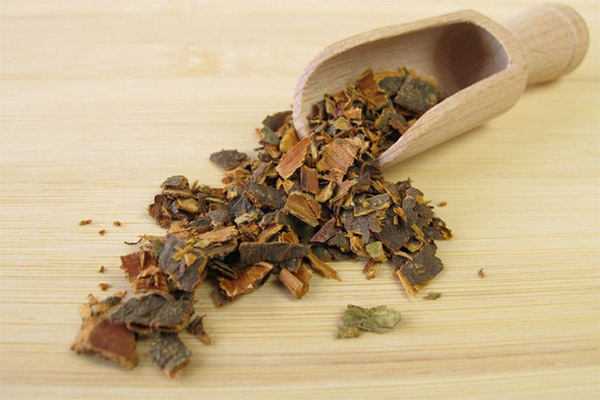
- Vitamin C. An irreplaceable element in the human body. A deficiency of this vitamin has serious health consequences. It not only strengthens the immune system, but also improves the condition of the skin, contributing to the production of collagen. It is also one of the most affordable antioxidants.
- Essential oils. They have an antibacterial property. They are often used to treat respiratory organs, they increase the body's resistance to infections, have a calming effect on the nervous system and are able to relieve symptoms of depression.
- Alkaloids. Based on these substances, some drugs are synthesized. They have an analgesic effect. They also help fight stress and help improve sleep.
- Tannins. They allow you to cope with intestinal disorders, have a positive effect on the gastrointestinal tract, remove toxins and toxins from the body. They are also famous for their anti-inflammatory effect, destroy dangerous bacteria and protect against infections.
- Apple acid. Increases the body tone and normalizes it, improves metabolism and lowers blood pressure. It also restores acid-base balance and enhances immunity.
- Chrysofan acid. It improves the excretion of fluid in the intestines, is a natural dye.
- Pectins. Digestive processes are brought back to normal, improve blood circulation, lower blood cholesterol. Pectins are also able to restore the intestinal microflora, which is very useful after a course of antibiotics.
In addition, the bark contains magnesium, potassium, iron, manganese, copper and boron, so buckthorn bark is an incredibly useful tool in folk medicine.
Collection and storage
It is necessary to collect raw materials for medicinal purposes in the spring. It is important to have time to do this at a time when the buds swell on the tree, and the flowers have not yet appeared. It is during this period that juice begins to stand out actively.The tree becomes soft, the bark separates easily. In addition, if you cut the bark during this period, the tree will be able to quickly recover.
Alder buckthorn is most suitable for treatment. The tree must be 10-15 years old and its height up to 3 m. Young trees are not suitable for collecting medicinal raw materials, since they have not yet had time to accumulate useful active substances.
At the selected tree, you need to determine the place where the bark begins to exfoliate. It is better to cut the bark at a distance of more than 20 cm from the roots. The thickness of the cut material should not exceed more than 2 mm. To easily remove the bark, you need to make several circular sections along the trunk. The distance between them should be within 20-30 cm. Next, you need to make one longitudinal section, after which you can remove the raw materials. Some people simply peel off the bark with a knife, but this is not recommended, since a large amount of wood can remain in it. Any extraneous growths on the cortex (for example, lichens) must be cut off without fail.
Drying raw materials is recommended outdoors and preferably under a canopy. It must be spread in a thin layer on burlap or paper. It is important to mix the bark regularly so that it dries from all sides. In the morning, dew can accumulate on the bark, so it is recommended to cover it with a waterproof cloth, but it can be brought into the house. During drying, black spots may appear on the crust, they must be removed on time.
Raw materials are considered ready when juice ceases to stand out. This can be determined by making a break. If the bark has dried out sufficiently, then even with a little effort, a crack will be heard. Readiness is also indicated by the red-brown color of the inside. For medicinal purposes, you can only use bark that has been stored for at least a year, so you always need to procure raw materials for the future. Store bark in a well-ventilated and dry room. Subject to these conditions, the shelf life can reach 5 years.
The healing properties of buckthorn bark
The beneficial properties of this drug are due to a rich set of useful substances. First of all, it is appreciated by its effect on the gastrointestinal tract. She is able to cope with constipation, while her action is quite long. In addition, the cortex begins to work after entering the intestines.
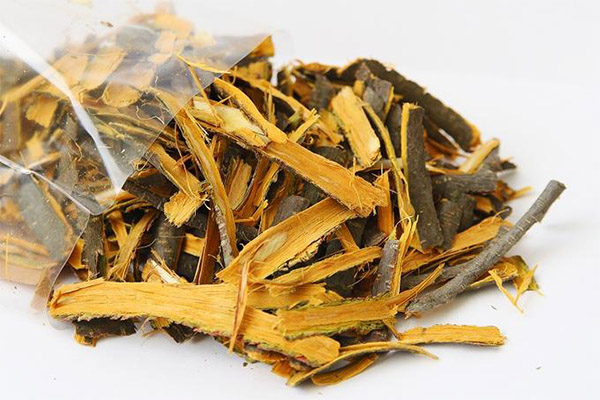
Buckthorn is also used for the complex treatment of ulcers, hemorrhoids or intestinal problems. It is a component of the collection of herbs that is used to treat worms. Buckthorn-based tincture accelerates wound healing, and bathing with this medicine can help treat scabies.
For women
Buckthorn bark is often used in gynecology. She is prescribed to women after childbirth to soften the stool. Also, decoctions and fees are prescribed to women with menopause. Buckthorn bark is an excellent way to get rid of acne and rejuvenate the skin. External treatment with a decoction of buckthorn bark can relieve inflammation on the skin. Also in antiquity buckthorn bark was used as a natural hair dye. Harvesting buckthorn with lemon balm and valerian can help with hormonal disruptions and menstruation problems.
For men
This medicine does not have any specific effect on the male body. Men can use it to treat skin diseases. The benefits of buckthorn and constipation are undeniable. In addition, it improves the functioning of the genitourinary system and kidneys, is often a component in medicines for the treatment of hemorrhoids, relieves inflammation and reduces bleeding. It can be used not only for internal use, but also to make enemas. It is useful for hemorrhoids by thinning feces, which makes the bowel movement less painful.
During pregnancy
During pregnancy, women often turn to traditional medicine. They are convinced that taking drugs is harmful, and they believe that traditional medicine is completely harmless. However, it is worth remembering that such powerful drugs as morphine are also synthesized from plants. Therefore, you can’t take them thoughtlessly. Buckthorn bark is also prohibited during pregnancy.Its use, especially long, is fraught with miscarriage.
For kids
Giving buckthorn to children under 15 years of age is strictly forbidden, its use at this age can cause problems with the gastrointestinal tract. Older children can be given buckthorn, but not in any form and in limited quantities. With prolonged use, this drug can negatively affect the child's body, since it has a certain toxicity. Another contraindication for children is individual intolerance. In some cases, allergic reactions may occur, in which case you need to stop taking the medicine. From time to time it is useful to give children buckthorn in the form of tea, but not in its pure form, but with the addition of other herbs. This will relieve fatigue and protect the body from viruses.
When losing weight
This tool is a valuable helper for losing weight people. The bark not only has a laxative effect, quickly removing processed food and toxins from the body, but also improves digestion. The metabolic process improves, a person feels light in the body, and fats begin to break down faster. It is recommended to use buckthorn in combination with protein diets and the use of vitamins.
However, eating buckthorn has a downside. For example, if a person is prone to overeating, then the bark will not give any effect, since it can not reduce the amount of calories entering the body. Buckthorn also enhances appetite, which can negatively affect weight loss. Long-term use of the drug is undesirable, since along with toxins useful substances are washed out from the body.
Buckthorn bark in folk medicine
Buckthorn bark has been used in folk medicine for a long time to treat many diseases, but mainly as a laxative. However, it is worth remembering that in large quantities it can be dangerous, so do not be too zealous and often take medications based on buckthorn bark.
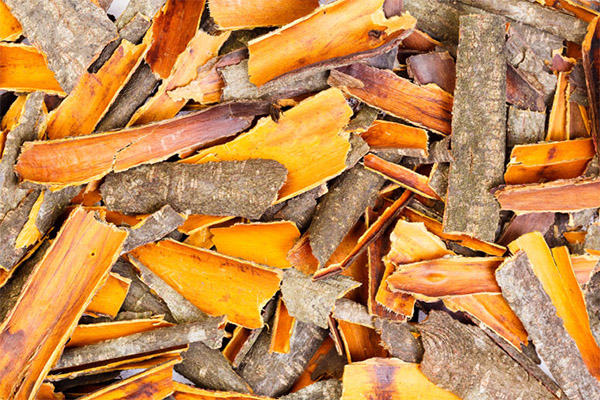
For constipation
When the digestive system is working properly, the intestines are released without much stress. With constipation, a person experiences certain difficulties with this and sometimes for several days can not go to the toilet. This is very dangerous for the body, so urgent need to take action. There are a large number of drugs, but do not get too carried away with pills, it is better to pay attention to traditional medicine.
Buckthorn copes with this problem better than others. It's all about her soft action, the elderly love her very much for that. In addition, if constipation is often replaced by diarrhea and is accompanied by intoxication or bloating, buckthorn can also help and remove all symptoms due to the content of tannins.
Buckthorn bark, prepared in any way, helps with constipation, however there is a recipe that stands out for its effectiveness against the rest:
- 1 teaspoon of crushed bark;
- 200 ml fat-free kefir;
- 1 teaspoon of fiber;
- a pinch of cinnamon.
Mix buckthorn with fiber, pour kefir and add cinnamon. Mix thoroughly and leave at room temperature for 30-40 minutes. Eat the mixture before meals in small portions.
For weight loss
Thanks to the composition rich in useful substances, buckthorn becomes a loyal assistant to losing weight people. Also, buckthorn bark contains antraglycosides, which are considered a rather rare substance. Unlike other drugs for weight loss, buckthorn acts gently and more effectively. The most useful for losing weight people are:
- Decoction in a water bath. Will require 2 tbsp. tablespoons of raw materials and a glass of water. Pour buckthorn in a glass bowl with hot water, then cover. Boil water in a saucepan first, put a container with broth in it and cook for 20 minutes. Next, cool the liquid to room temperature, strain, squeeze the raw materials and pour into a permanent storage tank. Use no more than 1/2 cup per day.
- Tea. In order to lose weight, you can brew tea with boiling water. For one cup, you need 1 teaspoon of raw materials.Use at night, but not daily.
Against parasites
For this purpose, use the collection of drugs. Each of them has its own advantages, and in combination they have the necessary effect on the body. This recipe copes well with worms. To prepare it, you need to take:
- 10 g of buckthorn bark;
- 10 g of wormwood;
- 10 g of tansy;
- 10 g of oak bark;
- 0.5 l of boiling water.
Grind herbs, mix, pour boiling water. Leave for 15-20 minutes at room temperature, then drink 2 tbsp. spoons before eating. The course of treatment is 14 days.
For problems with the liver and gall bladder
For these purposes, it is customary to use an infusion from a drug collection. In combination with other means, buckthorn tones up, improves metabolism and helps to eliminate toxins from the body. To prepare the medicine you will need:
- 1 teaspoon lemon balm;
- 2 tsp mint;
- 2 teaspoons immortelle flowers;
- 2 teaspoons buckthorn bark;
- 5 teaspoons of celandine;
- 6 teaspoons of rose hips.
All ingredients must be carefully ground for convenience and mixed. Immediately pour all the raw materials is not worth it, it is better to cook a new portion daily. For it, you need 1 teaspoon of the mixture to pour a glass of boiling water. Drink medicine with honey, regardless of food intake. It is advisable to store the mixture that is not used at the moment in a cloth bag. The minimum course of treatment is a week, but it can be adjusted upward depending on the patient's condition.
For stomach pain
Despite the ability of buckthorn to cope with this problem, it is still recommended to consult your doctor before taking the medicine, since in some cases buckthorn can only make it worse. If the doctor permits taking the drug, he will indicate the dosage, which in no case should be violated. The permitted dose of the drug depends on the disease causing the pain in the stomach, but usually it does not exceed 50 ml. You need to take the drug before meals. The duration of the course should not exceed 14 days.
As an anesthetic, take decoctions. 200 ml of boiling water will require 2 tbsp. tablespoons of raw materials. Pour the chopped buckthorn with boiling water and send to a water bath for 15–20 minutes, then insist for an hour. Strain, then return to the original volume of liquid with warm water. Drink 1/2 cup before bedtime.
After you start taking the drug, side effects in the form of flatulence or abdominal pain can be observed. In this case, you need to reduce the dosage of the drug.
From scabies
This disease gives people serious discomfort. And if nothing is done, then the consequences for the body can be disastrous. Infusion of buckthorn bark is an excellent antiseptic, it is able to eliminate itching and other unpleasant sensations in skin diseases.
For skin treatment, a classic decoction is prepared - 2-3 cups of boiling water per glass. spoon bark. Insist for several hours at room temperature. Apply this decoction externally, applying it only to clean skin. It is necessary to treat the skin at least three times a day, lubricating with infusion the damaged skin areas.
Depending on the severity of the disease, the course of treatment lasts 14-20 days. If necessary, it can be extended without fear, since the external use of buckthorn bark has no side effects.
With hemorrhoids
Often the cause of this disease is chronic constipation, so the use of buckthorn bark as a medicine is doubly justified. With constipation, feces become harder, and at the exit they provoke an exacerbation of hemorrhoids and open bleeding. To treat hemorrhoids, infusions and decoctions are used. They not only contribute to the liquefaction of feces, which facilitates the process of defecation, but also relieve inflammation and eliminate bleeding.
Infusions with decoctions can be drunk or made based on enemas. The choice of method of application is determined by the severity of the disease. To prepare a medicinal decoction, you need 1 teaspoon of bark and 0.5 liters of boiling water. Pour raw materials with water and leave to infuse for 10 hours. Heat the medicine a little before use.
Types of healing compounds
There are a large number of ways to prepare a medicine from buckthorn bark. It can be used not only for internal use, but also for external use. Each cooking method is aimed at certain health problems and enhances certain useful properties of raw materials. Buckthorn allows you to treat a large number of diseases, but it is important to choose the right method of preparation and dosage.
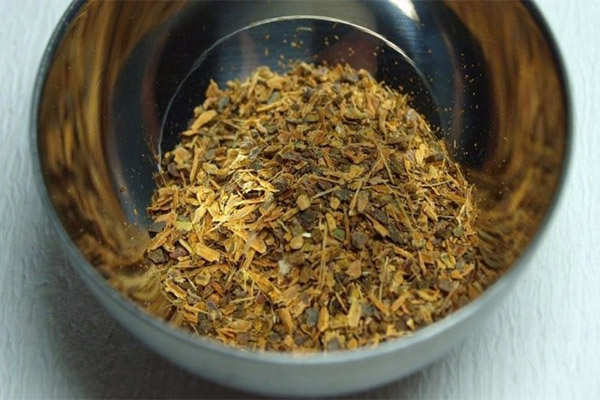
Infusion
Infusion in a water bath allows you to successfully fight constipation. However, this medicine does not work immediately, but after a few hours, so it is recommended to take it before bedtime. Also, the infusion can relieve suffering due to hemorrhoids. You can drink the medicine or make enemas.
For cooking, you need 1 teaspoon of crushed buckthorn bark and 0.5 l of boiling water. Pour raw materials with boiling water, then cover and leave to infuse at room temperature for at least 10 hours. Take during the day in small sips.
It is also worth remembering that this remedy is a diuretic, capable of combating inflammatory processes.
Tincture
Alcohol tincture is especially effective for treating skin diseases. It relieves inflammation, removes acne, cleanses pores. For these purposes, it must be applied externally, wiping the problem areas with a cotton swab dipped in tincture.
To prepare it, you need 1 tbsp. spoon of buckthorn bark and 0.5 liters of alcohol diluted to a strength of 25-30%. Dilute alcohol with clean water. It is advisable to fill the tincture in a glass bottle, and store it in it. Grind the raw materials, pour alcohol, tightly cork the bottle and put in a dark place for 2 weeks. After this period, strain the liquid.
Decoction
Of all the methods for preparing medicinal raw materials, the most effective can be called a decoction. It is also used to treat constipation, but, in addition, it is able to normalize the work of the liver and gall bladder. It can also be used to treat acne and other skin diseases.
For the broth you need 1 tbsp. spoon of raw materials and 0.5 liters of water. Pour buckthorn with water, bring to a boil, then reduce the heat and cook the broth for another half hour. Remove the finished medicine from the fire, cool at room temperature. Consume 1 tbsp. spoon.
Tea
Hot tea from buckthorn bark can be used in many cases. This is a good sedative that can improve sleep and relieve tension in the nervous system. This tea also strengthens the immune system. However, do not forget that buckthorn is a powerful laxative. Tea preserves this feature, so you should not use it too often. It is recommended to drink it no more than one cup in 2-3 days.
Tea from buckthorn bark is loved by losing weight people, and it is often included in their diet menu. However, exceeding the permissible dose can have sad consequences for the whole organism as a whole, up to convulsions. If you experience slight dizziness, you should immediately stop drinking the drug. In addition, prolonged use of this drug is addictive, and in the future it is difficult for the intestines to switch to a new mode of operation.
Another side effect of tea can be called a strong diuretic effect, so together you need to drink a large amount of liquid, ideally mineral water.
You can not give tea from buckthorn bark to children under 15 years old, even when assembled with other herbs. It is also contraindicated in pregnant and lactating mothers.
The recipe for tea is very simple. It will take 1 teaspoon of crushed bark and a cup of boiled, chilled water. Bark should be filled with water and left for 12 hours at room temperature. Since tea should be infused for so long, it is advisable to pour it in the morning and stir it regularly throughout the day. After 12 hours, strain, heat a little and drink before bedtime. You can pour bark and boiling water, but its effectiveness will be slightly lower.
Often, tea is harvested using a collection that includes buckthorn bark (20 g), caraway seeds (10 g), chamomile flowers (10 g) and centaury (5 g). Grind the mixture thoroughly and mix, pour warm water and leave for 10-12 hours. Strain and heat before use.
Application in cosmetology
For cosmetic purposes, a special brittle buckthorn is used. The name speaks for itself, the branches of this tree break at the slightest effort. A decoction of the bark of this tree has a pronounced anti-inflammatory effect, which allows it to be used effectively for the treatment of acne and acne. For problems with oily skin, it is enough to moisten your face with alcohol tincture daily.
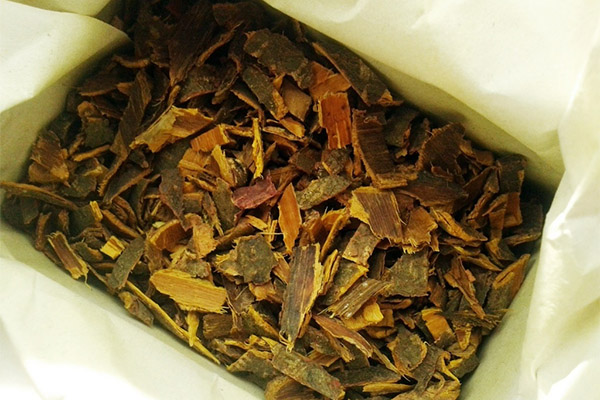
For other skin problems, acne, clogged pores, healing baths with buckthorn bark can help. It is necessary to cook a small amount of broth, then pour it into a hot bath and mix thoroughly. Strengthen the effect of medicinal raw materials by adding to the decoction of oak bark, chamomile and other medicinal herbs. In addition, baths with buckthorn bark have a sedative effect. They can help relax after a hard day and calm the nervous system.
A decoction of bark allows you to fight dry skin. To do this, apply lotions to the face. On a piece of tissue, make cutouts for the eyes, then dip in a decoction and attach to the face. As soon as the fabric dries, it can be slightly moistened without removing it from the face. The drug will draw out all microbes and harmful substances from the skin, so in no case should you use the same tissue for the next procedure. One session is enough to have a healing effect, acne became less noticeable, and inflammation decreased.
In addition, in cosmetology the ability of buckthorn to restore collagen in the skin is appreciated, which allows it to rejuvenate. A decoction of buckthorn bark should be poured into a mold for ice, and when the liquid freezes, wipe your face with this ice in the morning and evening. Enough 30 days of continuous therapy to manifest the effect. Wrinkles will become slightly less noticeable, and the skin itself will become more elastic.
In ancient times, buckthorn bark was used as a natural dye for hair. She is able to give them a chestnut tint. To dye your hair buckthorn, you need to prepare a strong broth. A minimum of 3 tbsp will be required. tablespoons in 0.5 liters of water. Pour raw materials with boiling water, then cover and leave at room temperature. The broth should be infused for a long time, at least 3 hours, so that the coloring matter has time to get into the water. Once the broth is ready, you need to apply it along the entire length, after which you wrap your hair with a towel and leave it for an hour. To make the color saturated, you need several procedures in a row.
Contraindications
Like any other medicine, buckthorn has a number of contraindications. First of all, this concerns problems with the intestines. For example, due to a laxative effect, it is forbidden to take buckthorn with diarrhea and other diseases that cause frequent bowel movements. People with a weak intestine who are prone to indigestion should not take buckthorn in any form, even for the treatment of other diseases. With colitis and bowel obstruction, it is also forbidden to take buckthorn. In general, in case of any serious malfunction of the gastrointestinal tract, you should consult your doctor before consuming buckthorn.
Nursing mothers and pregnant women are also forbidden to eat buckthorn. This can have a negative effect on the development of the fetus, the results are unpredictable.
External use has no particular contraindications. You can lubricate wounds or acne with decoctions for any diseases, however, it should be remembered that with the slightest allergic reaction, you must stop using this tool.
«Important: all information on the site is provided exclusively in fact-finding purposes. Before applying any recommendations, consult with a profile specialist. Neither the editors nor the authors are liable for any possible harm caused materials. "















